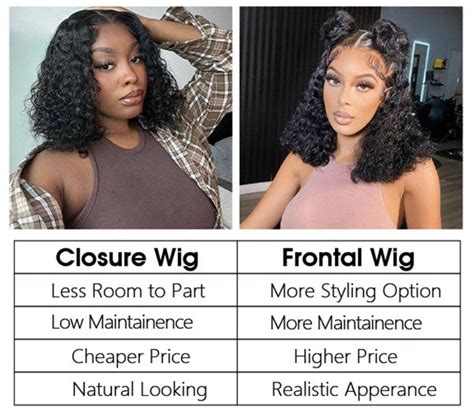Frontal vs. Closure: Understanding the Basics
When it comes to hair extensions, two popular methods stand out: closures and frontals. Both techniques offer unique benefits, but understanding their distinctions is crucial for making an informed decision.

What is a Closure?
A closure is a small, crescent-shaped piece of hair that covers the top of the head, extending from ear to ear. It’s typically used to create a natural-looking part that blends seamlessly with the wearer’s own hair. Closures come in a variety of sizes, the most common being 4×4 inches.
What is a Frontal?
A frontal is a larger piece of hair that covers the entire front of the head, from ear to ear and from the forehead to the crown. It provides a more extensive coverage than a closure, allowing for more versatility in styling. Frontals are generally longer in length, measuring 13×4 inches or 13×6 inches.
Pros and Cons of Closures and Frontals
Closures
Pros:
- Less expensive than frontals
- Smaller in size, making them easier to maintain
- Provide a natural-looking part and hairline
- Can be used to create a variety of styles, including updos
Cons:
- May not provide as much coverage as frontals
- Can be difficult to blend seamlessly with thicker hair
Frontals
Pros:
- Provide fuller coverage and versatility
- Allow for more complex and elaborate hairstyles
- Offer a more realistic and natural-looking hairline
- Can last longer than closures if properly maintained
Cons:
- More expensive than closures
- Larger in size, requiring more maintenance
- May not be suitable for all head shapes and hair types
Considerations for Choosing Between Closures and Frontals
The choice between a closure and a frontal depends on several factors, including:
- Desired coverage: A frontal provides more extensive coverage than a closure.
- Styling preferences: Frontals allow for more intricate hairstyles and greater versatility.
- Budget: Closures are generally less expensive than frontals.
- Head shape and hair type: Some head shapes and hair types may be better suited for closures or frontals.
Installation, Maintenance, and Care
Installation
Both closures and frontals require professional installation by a licensed cosmetologist. The process involves attaching the hairpiece to the scalp using methods such as bonding or sewing.
Maintenance
- Frequency: Frontals require more frequent maintenance than closures due to their larger size.
- Washing: Wash and condition the hairpiece regularly, using products specifically designed for extensions.
- Brushing: Avoid brushing the hairpiece excessively, as this can cause breakage.
- Styling: Use heat protectant products when using heat styling tools on the hairpiece.
Care
- Avoid over-manipulating: Handle the hairpiece gently to prevent damage.
- Sleeping: Avoid sleeping with your hairpiece wet or tangled.
- Professional maintenance: Schedule regular appointments with your cosmetologist for professional touch-ups and maintenance.
Common Mistakes to Avoid
- Improper installation: Have the hairpiece installed by a qualified professional to avoid damaging your natural hair or the hairpiece.
- Over-brushing: Excessive brushing can cause breakage and tangles.
- Using harsh products: Avoid using harsh shampoos, conditioners, or styling products on the hairpiece.
- Over-styling: Limit the use of heat styling tools on the hairpiece to prevent damage.
- Neglecting maintenance: Regular maintenance is essential to extend the lifespan of the hairpiece.
Innovative Applications: The Future of Hair Extensions
The hair extension industry is constantly evolving, with new techniques and technologies emerging. One innovative application is the use of “fluid closures.” Fluid closures are a type of closure that seamlessly blends with the wearer’s own hair, creating a natural-looking hairline and part. This technology addresses the drawbacks of traditional closures, such as visible lace or tracks.
Tables for Comparison
Table 1: Closure vs. Frontal Dimensions
| Hairpiece | Size |
|---|---|
| Closure | 4×4 inches |
| Frontal | 13×4 inches or 13×6 inches |
Table 2: Closure vs. Frontal Coverage
| Hairpiece | Coverage |
|---|---|
| Closure | Partial, from ear to ear |
| Frontal | Full, from ear to ear and forehead to crown |
Table 3: Closure vs. Frontal Costs
| Hairpiece | Estimated Cost |
|---|---|
| Closure | $150-$300 |
| Frontal | $300-$600 |
Table 4: Closure vs. Frontal Maintenance
| Hairpiece | Maintenance Frequency |
|---|---|
| Closure | Every 2-3 weeks |
| Frontal | Every 1-2 weeks |
Frequently Asked Questions (FAQs)
-
Which hairpiece is right for me, a closure or a frontal?
– The best hairpiece for you depends on your desired coverage, styling preferences, and budget. Consider consulting with a hair extension specialist for personalized advice. -
How long do closures and frontals last?
– With proper care and maintenance, closures and frontals can last anywhere from 3 to 12 months. -
Can I swim or exercise with my hairpiece installed?
– Yes, you can swim or exercise with your hairpiece installed, but it’s important to use a swim cap or wear the hairpiece in a protective style to prevent damage. -
How do I remove my hairpiece?
– Closures and frontals should be removed by a licensed cosmetologist using professional techniques to avoid damage to the hair or scalp. -
Can I dye my hairpiece?
– Yes, you can dye most hairpieces, but it’s important to consult with a hair extension specialist to ensure that the dye is compatible with the hairpiece material. -
How often should I touch up my hairpiece?
– Touch-ups will be required as your natural hair grows, typically every 2-4 weeks for closures and every 1-2 weeks for frontals. -
Can I sleep with my hairpiece installed?
– It’s not recommended to sleep with your hairpiece installed, as this can cause damage to the hairpiece and your natural hair. -
How much do closures and frontals cost?
– The cost of closures and frontals varies depending on factors such as quality, length, and brand. A typical closure costs between $150-$300, while a frontal costs between $300-$600.
